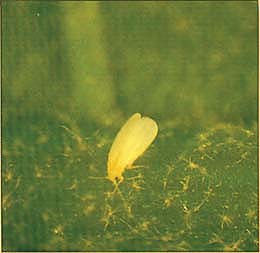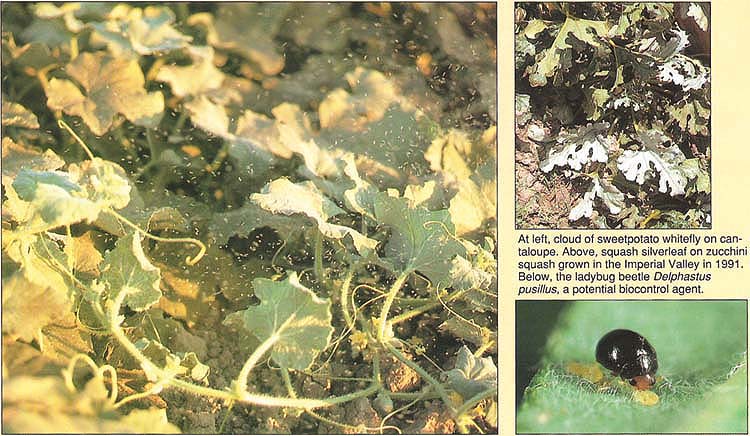All Issues
Sweetpotato whitefly: prospects for biological control
Publication Information
California Agriculture 46(1):25-26.
Published January 01, 1992
PDF | Citation | Permissions
Abstract
The damage to desert agricultural crops in Southern California and Arizona in fall-winter 1991 by the sweetpotato whitefly, Bemisia tabaci (Gennadius) is unprecedented in the history of the South west. Damage estimates exceed $200 million for California alone with the complete loss of the fall and winter melon crop and major damage to many winter vegetables and other crops. Origins of the problem, and potential biological control agents, are discussed.
Full text
The situation with the sweetpotato whitefly in the southwestern U. S. dramatically changed during 1990-91. This is apparently related to events that took place in Florida during the previous 4 years. Although the first record of the sweetpotato whitefly (Bemisia tabaci [Gennadius]) in the U.S. was from Florida in 1894, it was seldom more than a scientific curiosity. In 1986, Florida growers of greenhouse crops (especially poinsettias) experienced devastating outbreaks of sweetpotato whitefly that appeared to exhibit high levels of resistance to chemical control. In addition, outdoor vegetable crops, especially squash and tomatoes, also became infested. Because this was not a “new” pest in Florida or California, there were only limited regulatory actions to reduce the movement of this pest with plant material.
The result was that by 1987-88, many of the largest greenhouse poinsettias growers in California, all of whom received plant material from Florida, were infested, and over the next 2 years, this pest had spread to almost all the poinsettia growing areas of the state. Exactly how this insect spread into the desert valleys of California and Arizona is unclear, but the movement of infested vegetable transplants and/or poinsettia plants are suspected (see California Agriculture, pp. 10-12, Nov.-Dec. 1991).
Sweetpotato whitefly: new vs. old
In the summer of 1989, the first indication of yet another change in the whitefly population occurred with the sighting of squash silverleaf disorder in Pima and Maricopa counties of Arizona. By the summer of 1990, the silverleaf disorder was widespread in Arizona and California squash plantings. Then, in the winter, 1990 and the early spring, 1991, it became evident that the whitefly was occurring in unprecedented numbers on cole crops, particularly broccoli, in the Yuma and Imperial valleys. Accompanying these infestations was a phytotoxic disorder termed ‘white streaking’ which resulted from whitefly feeding. The presence of sweetpotato whitefly on cole crops in winter had never been experienced before. By July 1991, it was obvious that a major and catastrophic change had taken place in the whitefly situation in the Imperial and Palo Verde valleys and in the Colorado and Salt River valleys of Arizona. Considerable damage was sustained by cotton, squash, alfalfa, table grape vineyards and grapefruit plantings. In addition, squash silverleaf and another disorder associated with sweetpotato whitefly feeding, tomato irregular ripening, were present in California.
Because of inherent tendencies towards morphological variation in whiteflies, conventional taxonomists have not been able to discover characteristics in any of the life stages that could be used to separate the ‘ol’ vs. the ‘new’ sweetpotato whitefly. For lack of bettor terminology, these are now called the cotton and poinsettia, strains, or strain A and strain B, respectively- Electrophoretic work suggests that there are distinct differences between the whiteflies (see California Agriculture, pp. 10-12, Nov.-Dec. 1991). These data, together with information on basic biology (host preference, number of eggs laid, etc.) and the ability of one strain (poinsettia) to cause the squash silverleaf disorder, argues for distinct strains and even perhaps different species. Definitive mating studies involving the two strains are ongoing as are studies utilizing more sensitive genetic analyses (e.g., whole DNA); this question should be resolved soon.
The cotton strain of the sweetpotato whitefly appears to be practically non-existent in California and Arizona; it has been replaced by the poinsettia strain in less than a 2-year span of time.
Biological control
Potential biological control agents of Bemisia tabaci include pathogens, predators, and parasites. In field crops, the control afforded by natural enemies in California can be substantial, but this does not always limit populations to below economic levels. In the greenhouse, biological control requires releases of natural enemies to be effective. Two courses of action are open for improving biological control in both settings. The first is to evaluate and employ suitable natural enemies from the existing North American fauna. The second is to introduce additional species from the Old World. Electrophoretic comparisons from populations sampled from many areas of the world suggest that a poinsettia strain exists in the Arabian peninsula; this may be a fruitful area to initiate a search.
Potential biological control agents
Work with biological control of the sweetpotato whitefly on poinsettia in greenhouses has been in progress since the insect became a problem in California greenhouses in 1987. The commercially available parasite, Encarsia formosa, has provided less than satisfactory control. This was true even when an inundative release approach was employed in a commercial greenhouse. Similarly, biological control by the Eretmocerus and Encarsia spp. present in desert valleys does not always adequately limit whitefly population growth in desert valleys. As a result, priority was placed on finding and evaluating other control agents. Several North American parasites and predators are being evaluated by researchers in California and Arizona for potential use in the greenhouse and field. These included, among others, the parasites Encarsia transvena, E. deserti, E. tabacivora, E. near formosa (‘Beltsville’ strain) and Eretmocerus californicus. The predaceous ladybeetle, Delphastus pusillus, and the big-eyed bug, Geocoris punctipes, are among some of the endemic predators being examined. Studies designed to understand basic biology of natural enemies as it relates to control capability include the evaluation of searching capacity, response to olfactory cues, and function and numerical responses. The ladybeetle, D. pusillus, has many favorable attributes including a voracious feeding capacity, high reproductive potential, a positive response to olfactory cues from whitefly-infested leaves, and the ability to discriminate and avoid feeding on parasitized whitefly scales. Based on these results beetles were shipped to the farm advisor in the Imperial Valley (Eric Natwick) so that they could be caged onto some whitefly-infested plants. The purpose was to to see if the beetles could survive in this area and whether they would have an impact on the whitefly population. Results from these limited studies were encouraging, especially on broccoli. However, much more needs to be done in order to fully evaluate the utility of the beetle.
At left, cloud of sweetpotato whitefly on cantaloupe. Above, squash silverleaf on zucchini squash grown in the Imperial Valley in 1991. Below, the ladybug beetle Delphastus pusillus, a potential biocontrol agent.
In addition to the North American natural enemies, several species of parasites and predators are known form the Eastern hemisphere. The parasites include seven additional species of Encarsia and Eretmocerus and at least one additional predatory ladybeetle. These natural enemies may be imported and evaluated as part of continuing USDA and University programs.
The use of entomopathogenic fungi is also being pursued. This approach has shown promise in greenhouse settings in humid environments. The potential under California field conditions is currently being evaluated.
Whether natural enemies are identified from North American or exotic fauna, how to best utilize these in a biological control program is a major area of investigation. Inundative releases may play a role in the greenhouse, but may be limited in a field setting because of a lack of commercial availability of natural enemies and the size of the area to be covered. It may be more prudent to utilize the natural enemies in an inoculative release at the beginning of a crop when whitefly populations are low. Another tactic may be to release into weedy areas, allow parasite populations to build followed by natural migration into commercial fields as whitefly populations increase. The addition of exotic natural enemies or conservation of existing fauna may play a role in reducing whitefly populations to persistently low levels.
We are confident that natural enemies will play an important role in the management of sweetpotato whitefly populations, but they must be coordinated with other strategies in an integrated approach.






